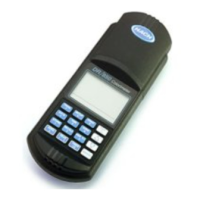212
Estimated Detection Limit
The estimated detection limit for program 39 is 0.04 mg/L Fe. For
more information on the estimated detection limit, see Section 1.
Interferences
Summary of Method
The TPTZ Iron Reagent forms a deep blue-purple color with
ferrous iron. The indicator is combined with a reducing agent
which converts precipitated or suspended iron, such as rust, to the
ferrous state. The amount of ferric iron present can be
determined as the difference between the results of a ferrous iron
test and the concentration of total iron.
Interfering Substance Interference Levels and Treatments
Cadmium Greater than 4.0 mg/L
Chromium (
3+
) Greater than 0.25 mg/L
Chromium (
6+
) Greater than 1.2 mg/L
Cobalt Greater than 0.05 mg/L
Color or turbidity If the sample is turbid, add one 0.1-g scoop of RoVer Rust Remover to the blank in
Step 6 (Step 3 for AccuVac procedure). Swirl to mix.
Copper Greater than 0.6 mg/L
Cyanide Greater than 2.8 mg/L
Manganese Greater than 50.0 mg/L
Mercury Greater than 0.4 mg/L
Molybdenum Greater than 4.0 mg/L
Nickel Greater than 1.0 mg/L
Nitrite Ion Greater than 0.8 mg/L
pH A sample pH of < 3 or >4 after the addition of reagent may inhibit color formation,
cause the developed color to fade quickly or result in turbidity. Adjust the sample pH
to 3–5 before adding reagent using a pH meter or pH paper and adding (dropwise) an
appropriate amount of iron-free acid or base (i.e., 1.0 N Sulfuric Acid Standard
Solution or 1.0 N Sodium Hydroxide Standard Solution). Make a volume correction if
significant volumes of acid or base are used.
IRON, TOTAL, continued

